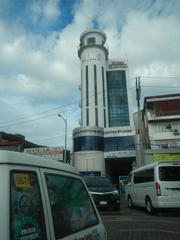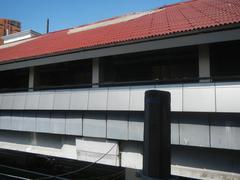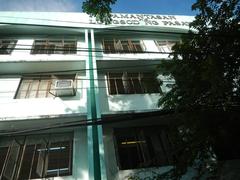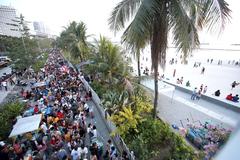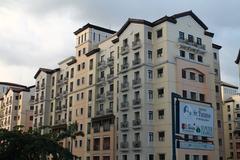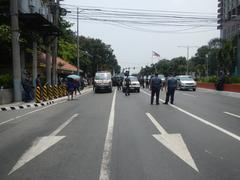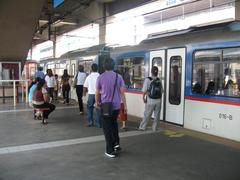Manila Film Center Visiting Hours, Tickets, and Complete Guide to Pasay’s Historic Landmark
Date: 04/07/2025
Introduction
The Manila Film Center is one of Pasay City’s most iconic structures, blending cultural ambition, architectural grandeur, and a haunting historical narrative. Conceived during the Marcos era as the centerpiece of the first Manila International Film Festival, the building’s story is marked by rapid construction, tragic loss of life, and enduring controversy. Today, it stands as both a monument to Filipino creativity and a memorial to those who perished during its construction. This guide provides comprehensive details on the Manila Film Center—covering its history, visiting hours, ticketing, accessibility, nearby attractions, and practical travel tips for anyone seeking to explore this enigmatic Manila historical site (Far Out Magazine; The Ghost In My Machine; MakeMyTrip).
Table of Contents
- Historical Background
- Visiting the Manila Film Center
- Architectural Features and Design
- Cultural Significance and Contemporary Role
- Urban Legends and Paranormal Lore
- Visitor Experience and Etiquette
- Frequently Asked Questions (FAQ)
- Summary and Key Tips
- References
Historical Background
Origins and Vision
The Manila Film Center was envisioned in the early 1980s by then-First Lady Imelda Marcos as a grand cultural landmark that would place Manila on the international arts and cinema map. The plan was to create a world-class venue for the inaugural Manila International Film Festival, positioning the Philippines alongside global film capitals. The original blueprint included multiple auditoria, exhibition halls, and film archives, though due to time and budget limitations, only the main auditorium and archive facility were realized (Far Out Magazine; The Ghost In My Machine).
Construction and Tragedy
Construction began in 1981 and was completed in just over three months—a testament to the regime’s urgency, but also a cause for concern. Over 4,000 workers labored around the clock, compressing weeks of work into days by using quick-drying cement and working in unsafe conditions. On November 17, 1981, a scaffolding collapse reportedly killed at least 168 workers, many of whom were buried in wet cement. The government’s response, marked by a media blackout and restricted rescue efforts, added to the site’s notoriety and contributed to its reputation as one of Manila’s most haunted buildings (Far Out Magazine; Esquire).
Visiting the Manila Film Center
Location and Accessibility
The Manila Film Center is situated at the southwest end of the Cultural Center of the Philippines (CCP) Complex, along Roxas Boulevard in Pasay City. It is adjacent to major landmarks like the Philippine International Convention Center, Coconut Palace, and SM Mall of Asia. Built on reclaimed land, its foundation rests on over 900 reinforced concrete piles for stability (Discover the Philippines; Everything Explained Today).
How to Get There:
- Public Transport: Accessible by bus (from EDSA terminals), jeepney (from MRT Taft Avenue), or LRT (nearest is EDSA-Taft station).
- Taxi/Ride-Hailing: Taxis and Grab are widely available; input “Manila Film Center” as your destination.
- Walking: From SM Mall of Asia, the center is within a 30-minute walk.
Visiting Hours and Tickets
- Exterior Viewing: The grounds and exterior are generally accessible to the public throughout the day.
- Interior Access: Entry is limited to scheduled events, film festivals, or guided tours. There is no regular daily admission; ticket prices vary by event.
- Guided Tours: Occasionally offered during special events or by arrangement; check with the Cultural Center of the Philippines for details.
- Ticket Purchase: Tickets for special events can be bought via the CCP’s official website or at the event venue.
Facilities and Travel Tips
- Accessibility: The grounds are partially accessible; ramps are present at main entrances, but some historic sections may be challenging for those with mobility issues.
- Amenities: Restrooms and a small souvenir shop are available when the building is open for events.
- Photography: Allowed on the exterior; interior photography may be restricted during events.
- Travel Tips:
- Wear comfortable shoes.
- Bring cash (PHP) for small purchases.
- Check weather conditions; Manila is humid, and sudden showers are common.
- Stay alert and follow local guidelines, especially after dark.
Nearby Attractions
- Cultural Center of the Philippines: Hub for theater, dance, and the arts.
- Folk Arts Theater: Another example of Marcos-era architecture.
- SM Mall of Asia: One of Asia’s largest malls.
- Star City: Amusement park within walking distance.
- Rizal Park and Intramuros: Located a short drive away, offering further historical and cultural experiences.
Architectural Features and Design
Designed by architect Froilan Hong, the Manila Film Center’s neoclassical style draws inspiration from the Parthenon, symbolizing Filipino cultural aspirations. Its imposing columns, grand lobby, and use of concrete convey both authority and artistic vision. The main auditorium, film archives (developed with UNESCO assistance), and the unique 360-degree theater are among its most notable features (Atlas Obscura; Everything Explained Today; Touristlink; Vigattin Tourism).
Cultural Significance and Contemporary Role
Despite its tragic history, the Manila Film Center remains a symbol of Filipino resilience and creative ambition. It continues to host occasional film screenings, art exhibitions, and cultural events, especially as part of the broader CCP Complex’s programming. The building’s story embodies the dual themes of artistic aspiration and political controversy, making it a site of both celebration and remembrance (MakeMyTrip; Holidify).
Urban Legends and Paranormal Lore
The Manila Film Center is famous for its tales of hauntings and supernatural phenomena, largely attributed to the construction tragedy. Reports of ghostly apparitions, unexplained noises, and cold spots have contributed to its reputation as one of Manila’s most haunted sites. These legends, including those surrounding the spirit of project supervisor Betty Benitez, have become part of Filipino pop culture and draw both paranormal enthusiasts and curious tourists (The Ghost In My Machine; Esquire).
Visitor Experience and Etiquette
- Respect: Given its history, visitors are encouraged to be respectful, especially during paranormal investigations or photo sessions.
- Events: Check event calendars and book tickets in advance for interior access.
- Safety: The surrounding area is generally safe, but standard precautions are advised.
- Best Time to Visit: Early mornings or late afternoons offer better lighting and cooler temperatures.
Frequently Asked Questions (FAQ)
Q: What are the Manila Film Center’s visiting hours?
A: The grounds are accessible throughout the day; interior access depends on scheduled events. Always check the latest event or tour schedules.
Q: How can I buy tickets?
A: Tickets for special events can be purchased via the Cultural Center of the Philippines’ website or at the venue.
Q: Is the Manila Film Center accessible for those with disabilities?
A: The grounds are partially accessible. Interior access may be limited; contact management for specific assistance.
Q: Are there guided tours?
A: Guided tours are occasionally available during special events; check with the CCP for updates.
Q: What are the nearby attractions?
A: SM Mall of Asia, Star City, Folk Arts Theater, CCP Main Theater, Rizal Park, and Intramuros.
Summary and Key Tips
The Manila Film Center embodies a unique blend of architectural brilliance, national ambition, and poignant history. Its location within the CCP Complex makes it a central part of Manila’s cultural itinerary. While regular public access is limited to the grounds and exterior, attending a special event or guided tour offers deeper insight into its significance. Visitors should plan ahead, check official schedules, and approach the site with respect for its layered legacy (Far Out Magazine; MakeMyTrip; Everything Explained Today).
For a richer experience, explore the nearby CCP venues and discover more about Pasay’s historical sites. Download the Audiala app for immersive guides and stay updated on Manila’s cultural events.
References and Further Reading
- Tragedy of the Manila Film Center, Far Out Magazine
- Haunted Globetrotting: The Manila Film Center’s Horrifying History, The Ghost In My Machine
- Places to Visit in Manila, MakeMyTrip
- Manila Film Center, Atlas Obscura
- Manila Film Center, Everything Explained Today
- Manila Film Center Haunted History, Esquire Philippines
- Sightseeing and Things to Do in Manila, Holidify
For more travel inspiration and up-to-date cultural guides, follow us on social media and explore related articles on Manila’s historical and cultural sites.
